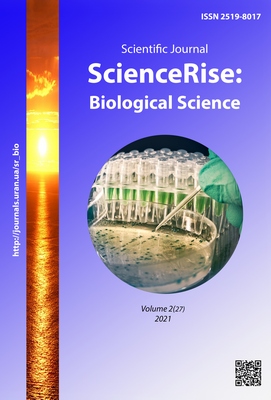Prevention of subinvolution of the uterus of cows using acidum succinicum
DOI:
https://doi.org/10.15587/2519-8025.2021.235936Keywords:
cows, calves, enzymes, acidum succinicum, subinvolution of the uterusAbstract
Aim. To establish the effect of acidum succinicum on the activity of enzymes in the blood of cows after calving and the course of uterine involution.
Materials and Methods. The study of enzyme activity was carried out in the Central Research Laboratory of I. Horbachevsky Ternopil National Medical University (Certificate of technical competence № 001/18, issued on September 26, 2018, valid until September 25, 2023).
Results of the research. After the use of acidum succinicum in the body of cows of the experimental group, the activity of alanine aminotransferase increased by 12,0 % (p≤0,05), and the activity of aspartate aminotransferase, on the contrary, decreased by 30,0 % (p≤0,001), which indicates a positive effect on hepatocytes. Confirmation of this is the Ritis factor, which increased 1,4 times (p≤0,05).
All animal experiments were conducted according to with the recommendations of ARRIVE and the British Animal Act 1986 and Directive 2010/63 / EU on the protection of animals for scientific investigation.
In the body of cows of the control group, the activity of alanine and aspartateaminotransferases increased, respectively, by 14,0 % (p≤0,05) and 47,0 % (p≤0,001) against a background of a 1,2-fold decrease (p≤0,05) Ritis factor.
A decrease in bilirubin content of 56,0 % (p≤0,001) in the body of cows after the use of acidum succinicum and an increase in its content by 2,2 times (p≤0,001) in the body of control cows indicates liver disease, which is accompanied by affection of its parenchyma, which may be a consequence of intoxication of their body in the last trimester of pregnancy.
Conclusion. Acidum succinicum, applied to cows after calving, prevents the development of inflammation of the reproductive system, helps to restore reproductive function, reduces the duration of the service period to 80,0±2,0 days, and the insemination index to 1,3
References
- Feren, N. M., Yaremchuk, V. R. (2015). Role of lipid peroxidation and antioxidant system in liverin the pathogenesis of experimental pneumonia and immobilizationstress and correction of their violations by corvitin. Medychna khimiia, 17 (1), 100–103.
- Pavliuk, M. V. (2017). Tekhnolohiia vidtvorennia silskohospodarskykh tvaryn. Ahrarna osvita, 140.
- Nekrasov, G. D., Sumanova, I. A. (2007). Akusherstvo, ginekologiya i biotekhnika vosproizvodstva zhivotnykh. Barnaul: Izd-vo AGAU, 204.
- Koreiba, L. V., Holub, A. A., Melnyk, Yu. O. (2016). Efficiency of treatment of postpartum endometritis in cows. Modern directions of theoretical and applied researches. Available at: https://www.sworld.com.ua/konfer42/178.pdf
- Slypaniuk, O. V. (2013). Osoblyvosti protsesiv peroksydnoho okysnennia lipidiv i stan nespetsyfichnoi rezystentnosti u tilnykh koriv ta yikh teliat za dii vitaminiv A, D, E, selenu ta interferonu. Zahalna patolohiia ta patolohichna fiziolohiia, 8 (1).
- Hevkan, I. I., Syrvatka, V. Ya., Shtapenko, O. V. (2016). Vyvchennia kompleksnoho vplyvu liposomalnykh preparativ nanochastynok Arhentumu i orhanichnykh mikroelementiv na biokhimichni pokaznyky krovi ta efektyvnist likuvannia endometrytiv u koriv koriv. Biolohiia tvaryn, 18 (3), 124.
- Fedorenko, S. Ya., Sklyarov, P. M., Koshevoy, V. P. (2017). Efektyvnist terapiyi koriv ta kiz z hipohonadyzmom za vykorystannya nanopreparatu «Kaplaestrol + OV». Naukovyy visnyk Lvivʹkoho natsionalnoho universytetu veterynarnoyi medytsyny ta biotekhnolohiy im. S. Z. Hzhytskoho, 19 (82).
- Semerunchyk, A. (2015). Osnovni aspekty likuvannia koriv, khvorykh na metryt Veterynarna medytsyna Ukrainy, 9 (235). Available at: https://www.biotestlab.ua/articles/osnovni-aspekti-likuvannia-oriv-khvorikh-na-metrit/
- Fedotova, E. A. (2016). Vliyanie «BSH–VIT» na profilaktiku poslerodovoy patologii u korov. Molodezh i nauka, 3.
- Semenyuk, Ya. S. (2021). Synchronization of the stage of sexual arousal andinsemination of cows. Zhytomyr, 37. Available at: http://ir.znau.edu.ua/bitstream/123456789/11136/1/Semenyuk_Ya%20S_211_2021.pdf
- Gilbert, R. O. (2016). Management of Reproductive Disease in Dairy Cows. Veterinary Clinics of North America: Food Animal Practice, 32 (2), 387–410. doi: http://doi.org/10.1016/j.cvfa.2016.01.009
- Green, A. S., Fascetti, A. J. (2016). Meeting the Vitamin A Requirement: The Efficacy and Importance ofβ-Carotene in Animal Species. The Scientific World Journal, 2016, 1–22. doi: http://doi.org/10.1155/2016/7393620
- Hemingway, R. G. (2003). The influences of dectary intakes and supplementation with selenium and vitamin E on reproduction diseases and reproductive efficiency in caule and sheep. Veterinary Research Communications, 27 (2), 159–174. doi: http://doi.org/10.1023/a:1022871406335
- Buso, R. R., Campos, C. C., Santos, T. R., Saut, J. P. E., Santos, R. M. (2016). 0122 Retained placenta and subclinical endometritis: Prevalence and relation with reproductive performance in crossbred dairy cows. Journal of Animal Science, 94 (5), 57–57. doi: http://doi.org/10.2527/jam2016-0122
- Gordon, I. R. (2017). Reproductive Technologies in Farm Animals. CABI, 342. doi: http://doi.org/10.1079/9781780646022.0000
- Burshtynova kyslota Available at: https://preparat.com.ua/ua/bad/Yantarnaya-kislota
- Vlizlo, V. V., Fedoruk, R. S. Ratych, I. B. (2012). Laboratorni metody doslidzhenʹ u biolohiyi, tvarynnytstvi ta veterynarniy medytsyni. Lviv: Vydavnytstvo «Spolom», 764.
Downloads
Published
How to Cite
Issue
Section
License
Copyright (c) 2021 Larysa Fedonyuk, Yaroslav Stravskyy, Vira Khavtur, Roman Sachuk

This work is licensed under a Creative Commons Attribution 4.0 International License.
Our journal abides by the Creative Commons CC BY copyright rights and permissions for open access journals.
Authors, who are published in this journal, agree to the following conditions:
1. The authors reserve the right to authorship of the work and pass the first publication right of this work to the journal under the terms of a Creative Commons CC BY, which allows others to freely distribute the published research with the obligatory reference to the authors of the original work and the first publication of the work in this journal.
2. The authors have the right to conclude separate supplement agreements that relate to non-exclusive work distribution in the form in which it has been published by the journal (for example, to upload the work to the online storage of the journal or publish it as part of a monograph), provided that the reference to the first publication of the work in this journal is included.









